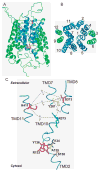Biology of the major facilitative folate transporters SLC19A1 and SLC46A1
- PMID: 24745983
- PMCID: PMC4185403
- DOI: 10.1016/B978-0-12-800223-0.00004-9
Biology of the major facilitative folate transporters SLC19A1 and SLC46A1
Abstract
This chapter focuses on the biology of the major facilitative membrane folate transporters, the reduced folate carrier (RFC), and the proton-coupled folate transporter (PCFT). Folates are essential vitamins, and folate deficiency contributes to a variety of heath disorders. RFC is ubiquitously expressed and is the major folate transporter in mammalian cells and tissues. PCFT mediates intestinal absorption of dietary folates. Clinically relevant antifolates such as methotrexate (MTX) are transported by RFC, and the loss of RFC transport is an important mechanism of MTX resistance. PCFT is abundantly expressed in human tumors and is active under pH conditions associated with the tumor microenvironment. Pemetrexed (PMX) is an excellent substrate for PCFT as well as for RFC. Novel tumor-targeted antifolates related to PMX with selective membrane transport by PCFT over RFC are being developed. The molecular picture of RFC and PCFT continues to evolve relating to membrane topology, N-glycosylation, energetics, and identification of structurally and functionally important domains and amino acids. The molecular bases for MTX resistance associated with loss of RFC function, and for the rare autosomal recessive condition, hereditary folate malabsorption (HFM), attributable to mutant PCFT, have been established. From structural homologies to the bacterial transporters GlpT and LacY, homology models were developed for RFC and PCFT, enabling new mechanistic insights and experimentally testable hypotheses. RFC and PCFT exist as homo-oligomers, and evidence suggests that homo-oligomerization of RFC and PCFT monomeric proteins may be important for intracellular trafficking and/or transport function. Better understanding of the structure and function of RFC and PCFT should facilitate the rational development of new therapeutic strategies for cancer as well as for HFM.
Keywords: Antifolate; Folate; Oligomerization; Proton-coupled folate transporter; Reduced folate carrier; Transporter.
© 2014 Elsevier Inc. All rights reserved.
Figures




Similar articles
-
The major facilitative folate transporters solute carrier 19A1 and solute carrier 46A1: biology and role in antifolate chemotherapy of cancer.Drug Metab Dispos. 2014 Apr;42(4):632-49. doi: 10.1124/dmd.113.055723. Epub 2014 Jan 6. Drug Metab Dispos. 2014. PMID: 24396145 Free PMC article. Review.
-
Functional Characterization of Reduced Folate Carrier and Protein-Coupled Folate Transporter for Antifolates Accumulation in Non-Small Cell Lung Cancer Cells.Drug Metab Dispos. 2024 Oct 16;52(11):1332-1344. doi: 10.1124/dmd.124.001872. Drug Metab Dispos. 2024. PMID: 39261014
-
Folate transporter dynamics and therapy with classic and tumor-targeted antifolates.Sci Rep. 2021 Mar 18;11(1):6389. doi: 10.1038/s41598-021-85818-x. Sci Rep. 2021. PMID: 33737637 Free PMC article.
-
The proton-coupled folate transporter (PCFT-SLC46A1) and the syndrome of systemic and cerebral folate deficiency of infancy: Hereditary folate malabsorption.Mol Aspects Med. 2017 Feb;53:57-72. doi: 10.1016/j.mam.2016.09.002. Epub 2016 Sep 21. Mol Aspects Med. 2017. PMID: 27664775 Free PMC article. Review.
-
The evolving biology of the proton-coupled folate transporter: New insights into regulation, structure, and mechanism.FASEB J. 2022 Feb;36(2):e22164. doi: 10.1096/fj.202101704R. FASEB J. 2022. PMID: 35061292 Free PMC article. Review.
Cited by
-
Potential Pathways for CNS Drug Delivery Across the Blood-Cerebrospinal Fluid Barrier.Curr Pharm Des. 2016;22(35):5463-5476. doi: 10.2174/1381612822666160726112115. Curr Pharm Des. 2016. PMID: 27464721 Free PMC article. Review.
-
Impact of genetic variants in the solute carrier (SLC) genes encoding drug uptake transporters on the response to anticancer chemotherapy.Cancer Drug Resist. 2024 Jul 18;7:27. doi: 10.20517/cdr.2024.42. eCollection 2024. Cancer Drug Resist. 2024. PMID: 39143954 Free PMC article. Review.
-
Folate Insufficiency Due to MTHFR Deficiency Is Bypassed by 5-Methyltetrahydrofolate.J Clin Med. 2020 Sep 2;9(9):2836. doi: 10.3390/jcm9092836. J Clin Med. 2020. PMID: 32887268 Free PMC article.
-
Folate Receptor Alpha Autoantibodies in Autism Spectrum Disorders: Diagnosis, Treatment and Prevention.J Pers Med. 2021 Jul 24;11(8):710. doi: 10.3390/jpm11080710. J Pers Med. 2021. PMID: 34442354 Free PMC article. Review.
-
Decitabine Sensitizes the Radioresistant Lung Adenocarcinoma to Pemetrexed Through Upregulation of Folate Receptor Alpha.Front Oncol. 2021 May 17;11:668798. doi: 10.3389/fonc.2021.668798. eCollection 2021. Front Oncol. 2021. PMID: 34079760 Free PMC article.
References
-
- Abramson J, Smirnova I, Kasho V, Verner G, Kaback HR, Iwata S. Structure and mechanism of the lactose permease of Escherichia coli. Science. 2003;301(5633):610–615. - PubMed
-
- Assaraf YG, Babani S, Goldman ID. Increased activity of a novel low pH folate transporter associated with lipophilic antifolate resistance in Chinese hamster ovary cells. The Journal of Biological Chemistry. 1998;273(14):8106–8111. - PubMed
-
- Brigle KE, Spinella MJ, Sierra EE, Goldman ID. Characterization of a mutation in the reduced folate carrier in a transport defective L1210 murine leukemia cell line. The Journal of Biological Chemistry. 1995;270(39):22974–22979. - PubMed
Publication types
MeSH terms
Substances
Grants and funding
LinkOut - more resources
Full Text Sources
Other Literature Sources
Molecular Biology Databases

